Ask anyone living in former West Berlin what there is to see in the eastern suburb of Marzahn and they’re almost certain to say, nichts – nothing. Well, nothing except a whole load of grim housing estates.
Press them further and they might also mention that the place is crawling with Vietnamese cigarette-smuggling mafia, neo-Nazis and Russian-German immigrants who don’t necessarily all get on.
Marzahn has such a bad reputation in fact that in 2007, local residents were prepared to strip off and pose nude in a calendar with the slogan, ‘Everyone is different — all are the same’. Obviously the calendar didn’t work – most people still view the area as bad voodoo.
But you know, you hear a lot of bad things about a lot of places (Tarlabasi in Istanbul springs to mind). I was curious, was it as bleak as everyone made out?
Some history: Marzahn is in the east of Berlin, 15-30 minutes from the city centre depending how you travel. It’s a borough (half of Marzahn-Hellersdorf) as well as being a neighbourhood within that borough. Like much of Berlin, Marzahn the neighbourhood was a separate village pre-1920, before being incorporated into Berlin. In 1949 it became part of East Berlin. Between 1976 and the late 80s it was transformed into a massive housing estate by the GDR. Today, the area is one of the least ethnically diverse – but with more Russian, Kazakh and Vietnamese people compared to other parts of the city.
Okay, let’s do it.
Part 1: Suburban life
Before I committed to the area, I decided to do a quick recce. But as the S-Bahn train rolled into Marzhan on a greyish Monday, I did wonder, whose idea was this again? What if a gang of neo-Nazis didn’t like the cut of my jib, or if the Vietnamese lads took a fancy to my camera?
We hit the mall first. Not a neo-Nazi or Vietnamese cigarette-smuggler in sight. Instead my first visual was of largish people eating enormous ice-cream sundaes, kids running past with free yellow balloons, women getting their nails hand-painted by the Thai girls at ‘Pretty Nails’. I wasn’t in scary east Berlin – I was in Sydney’s Liverpool.
Suburban, in other words, and so different to anywhere else in Berlin that I’d been so far.
For that reason alone, I decided it was on – Marzahn would be Suburb No 28.
For our first real visit to the area we took the tram, one of 21 tram lines in Berlin that are mostly in the former East. They’re a good way to see stuff and, as it turned out, meet people.
The first people we talked to were Katja and Paul, two social workers in their twenties. They were both born in former East Berlin and still lived in the east, but not in Marzahn itself. What intrigued me was how deeply they identified as East Berliners – they were only three years old when the Wall came down so theoretically they grew up in a re-unified city, where there was no longer an East or West.
But as I talked to them, the penny started to drop – there may not be a Wall anymore but there’s still an East and a West. Katja and Paul explained that they would never live in ‘West’ Berlin – “They’re a little arrogant.”
What was also interesting is that it’s easy to assume that everyone in the former East fled to the former West as soon as the Wall came down. But it’s not that simple. Katja and Paul were in Marzahn to visit Katja’s dad who has never left the area; despite everything, it’s his home.
Next we met Inga. I found out that she lives in Marzahn but not much more – we couldn’t speak eachother’s language. How long had she lived there? What did she think? I’ll never know.
We then met two young ‘Russian German’ girls. They were seconds away from hopping on a tram so I didn’t have time to get their names or their stories. But when I quickly asked them if they were German, they replied, “Russian German”. Which means they’re the descendents of ethnic Germans who moved to Russia a few hundred years ago. Since the late 1980s they’ve been allowed to return to Germany and many now live in Marzahn. But because the German language was banned in the USSR, a lot of them don’t speak German anymore. How strange would that be?
Part 2: The unexpected
When I asked various people what there was to see in Marzahn, no one mentioned Gärten der Welt – Gardens of the World. Maybe they’d heard of it but having never been, assumed it must be some crappy tourist thing. I kind of did. I read about it somewhere and thought, well, better have a look but it’ll probably be dinky.
Not so. It was so impressive that Coco and I spent hours wandering around the various gardens, which include Chinese, Japanese, Balinese and Korean.
What made it really special were the people we met there. I’d expected to see shaven heads in Marzahn but not these ones…
15 year old Manop, above, and his friends are Thai Buddhist trainee monks. While they live in south Berlin, they were having a day out in the sun. I discovered them as I went in search of water for Coco and I – there they were, a blur of saffron, eating ice-cream. And that’s how we ended up wandering around the Gärten der Welt with a whole load of Thai monks-to-be. I was especially taken by 10 year old Dominique; half Thai, half German, he was cheeky-polite-serene, all at the same time.
Other images from the Gardens of the World…
Part 3: Those housing estates
You know I like a massive building or a well-designed public housing estate.
But unlike Hong Kong’s Lai Tak Tsuen or Berlin’s Hansaviertel or Gropiusstadt, where the buildings have been individually designed and are not on a massive – like really massive – scale, East Berlin’s housing estates are cookie-cutter and relentless. A friend who visited a few weeks ago told me she flew over what looked like handfuls of giant letters – judging from the Google Earth image below, I think she was peering down at Marzahn.
Wandering around some of the buildings all I could think was, if life here seems depressing today, how bad must it have been between 1961 and 1989, when the Wall was up? At least now you can look forward to a nice dinner in your not so nice apartment – maybe pick up a little exotic something from the local Vietnamese markets – but back then it was just pickles and potatoes.
(Remember Birgit from Friedrichshain? She told me about the East Berlin pensioners who were allowed to visit the West during that period; they would return home quite traumatised after seeing the bountiful offerings in the food department of KaDeWe, West Berlin’s version of London’s Harrods. I thought at least they could have a good feed while they were there – but they were too poor and their marks were worth nothing against the Wests’. Gut-wrenching, literally.)
Part of the problem is the housing estates consist of Plattenbauten – buildings made from mass-produced pre-cast concrete slabs, up to 22 stories high. After the war when the alternative was overcrowded, partially bombed pre-war housing, they were highly prized. Today I imagine their only appeal is that they’re cheap.
But hang on, isn’t this project meant to be about finding the beauty and/or the positives in places you might not expect them?
Okay, I’ll give it my best shot… Some of the Plattenbauten have been modernised, painted cheery colours, cut down in size (easy when you’re dealing with modular slabs). There’s a lot of greenery around, not to mention the beautiful Gardens of the World. And – yes, there’s more – there’s loads of space and pretty good facilities for young families.
If you live in one of the blocks managed by the company Degewo, there’s even a “noise police” amongst other “authorities” to “provide for order and security”.
But no matter what they do to improve the aesthetics or how many Gardens of the World they build, there are still major problems in Marzahn. At the local mall we met a couple who live here, Gina and Rob. (Just like Katja and Paul, Gina thinks of herself as an East Berliner, despite the fact she’s lived for 23 of her 25 years in a re-unified city. Nor does she like those in the west particularly – “They act like they’re better.”)
They explained that one of the real problems was the lack of entertainment options for young adults. Without any bars even, they tend to sit around the streets, drinking, doing drugs. They also said there were too many immigrants – Russians and Vietnamese in particular. (They didn’t mention the neo-Nazis but I can’t imagine they like the immigrants much either.)
Feeling slightly gloomy about the place, we headed back to town. But not before we’d had a little ray of sunshine come our way care of a bright yellow Trabant or Trabi – the car that was manufactured by the GDR. The first thing I did when I saw it? Poked my finger at it; the Trabant is known as the ‘plastic’ car, a mixture of formica and bakelite, so I wondered what it felt like. It was surprisingly hard – for a plastic car.
Part 4: Still no neo-Nazis or Vietnamese mafia
Instead I found some punks. Loads of them. Because sleepy ole’ Marzahn was putting its mohawk on for a few days, hosting a punk music festival, Resist to Exist.
I met some of them outside the mall, there to refuel before heading back over to the festival.
When I asked them all where the festival was exactly, they sort of threw their arms around and said vaguely, over there. So I could be wrong but it would appear they were happily partying near a former Roma concentration camp. It was 1936 and Berlin was about to host the Olympic Games. Hitler didn’t want Berlin’s Roma gypsies around so he had them rounded up and taken to a field in Marzahn sandwiched between a cemetery and a sewage dump. They stayed there until they were deported to Auschwitz in 1943.
There’s a memorial stone in the cemetery commemorating the Roma camp.
It reads: ‘From May 1936 until the liberation of our people by the glorious Soviet Army suffered in a camp not far from here hundreds of nationals of the Sinti. Honor to the victims’.
The cemetery itself is very sweet, if a cemetery can be sweet – full of incredibly well-tended plots. I just hope the Roma memorial has some visitors from time to time.
On the last day we visited a great big storm was brewing in the distance. It suited the place – dark, moody Marzahn.
The Wrap
Well, I never did find a neo-Nazi nor any Vietnamese cigarette-smuggling mafia. (I did try and photograph some Vietnamese if you’re wondering – they politely refused.) But I found monks and punks, and that rare specimen, the Trabant. Beautiful gardens from all around the world. And a memorial for a people for whom life still isn’t easy – but a whole lot better than it was in 1936.
Nothing to see in Marzahn? I beg to differ.
On the ‘home front’
“How’s the last week been for you Coco?”
“Good.”
“Why?”
“Well, I really loved the Gardens with the monks and the maze. Yeah.”
—
This suburb has been brought to you by Karen McWilliam
—
This is the penultimate Berlin post – next week’s will be our last. And then it’s over the Atlantic to New Yoik. Anyone keen?
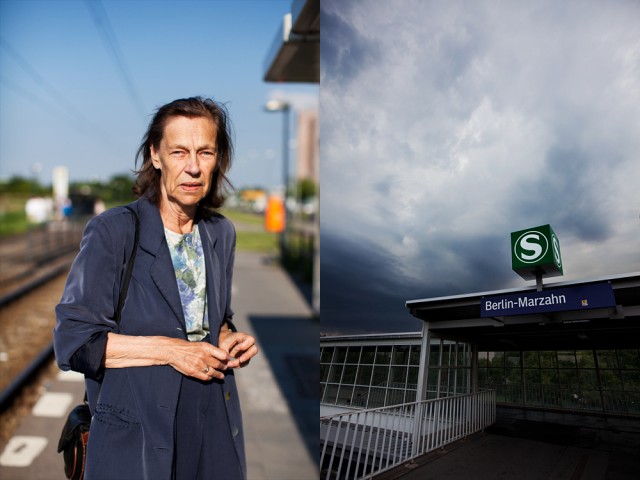

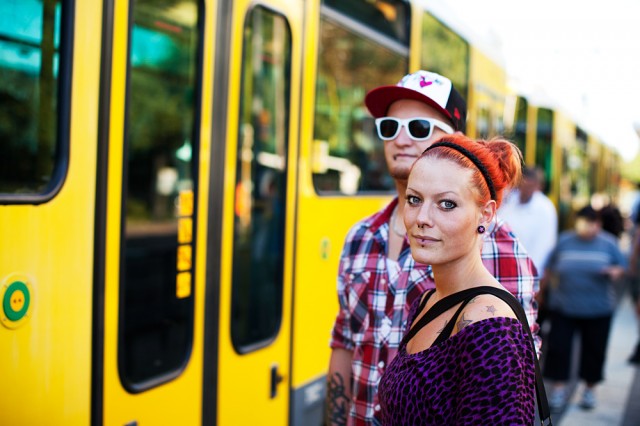
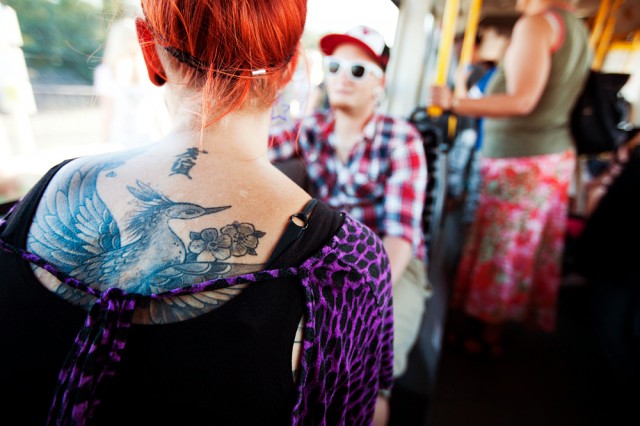
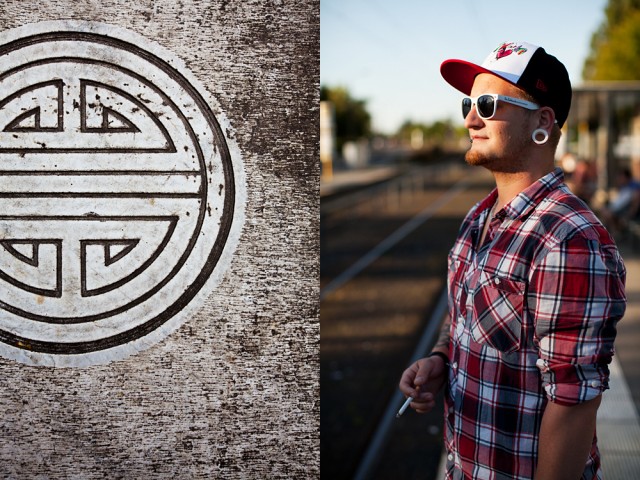

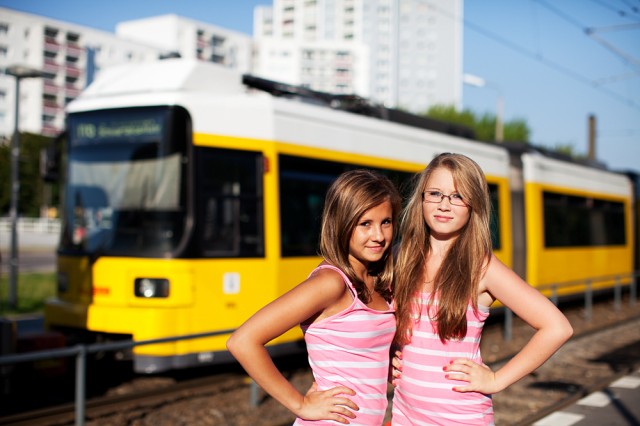
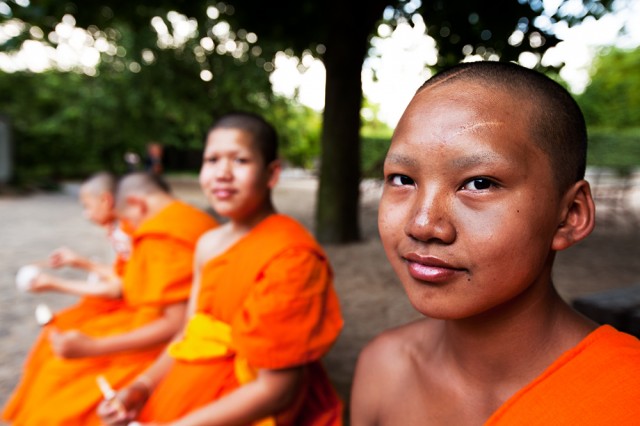

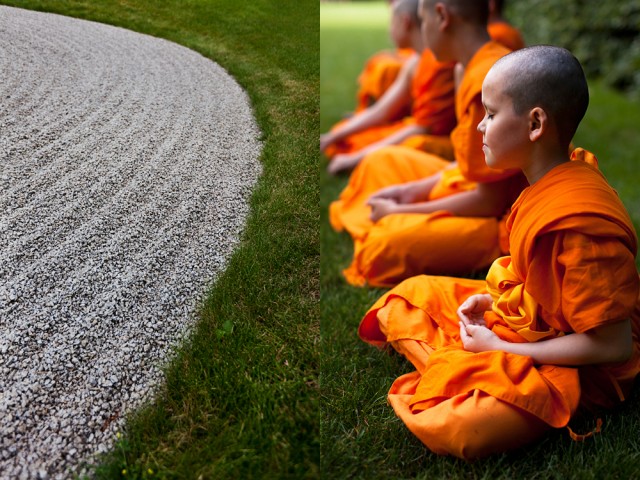
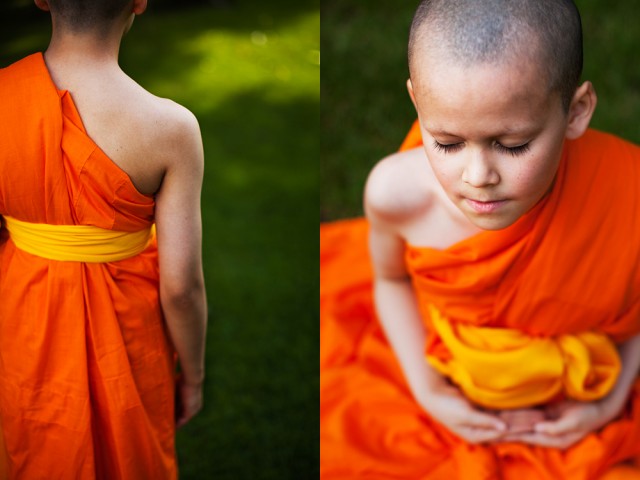
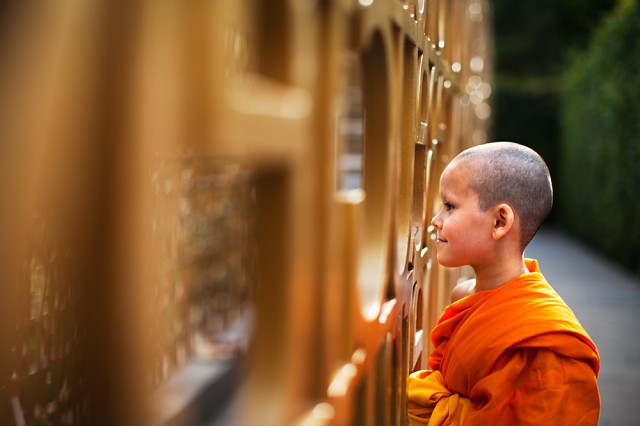
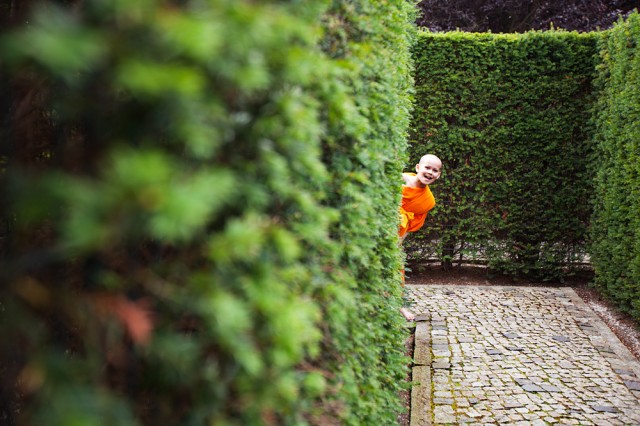

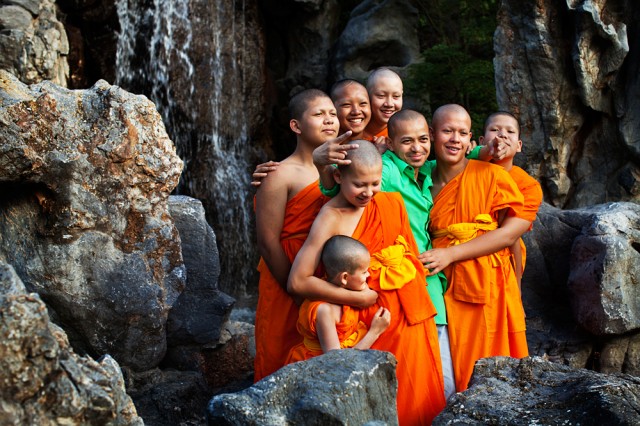
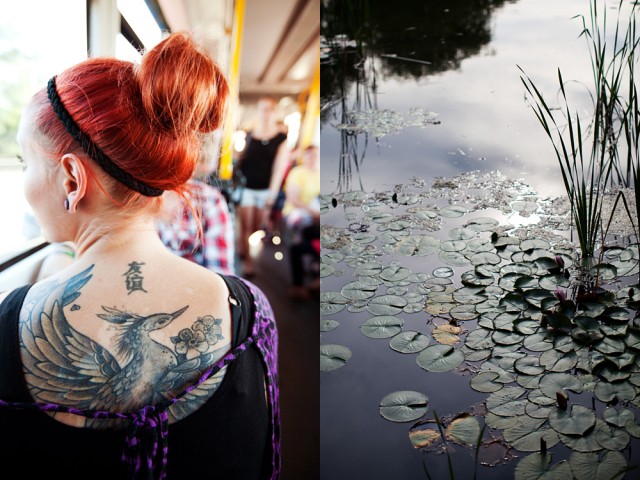


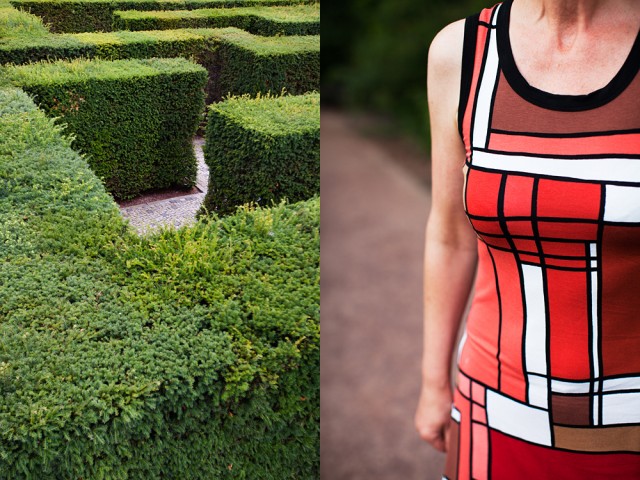
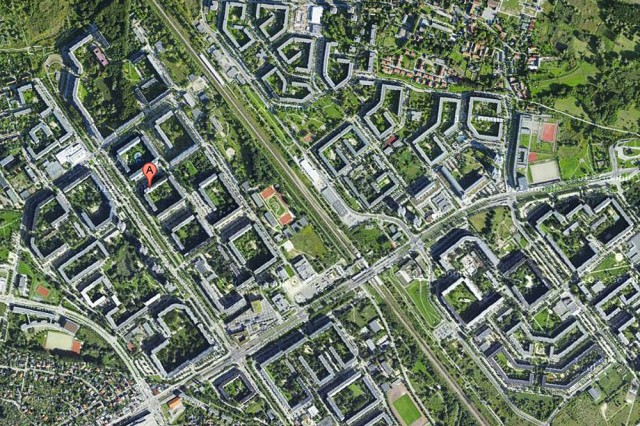
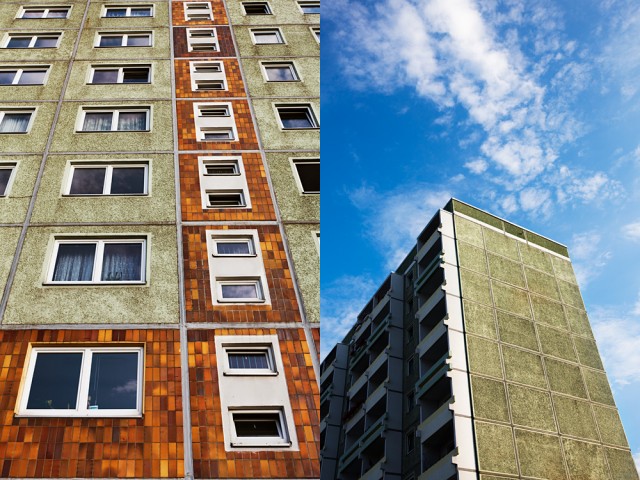
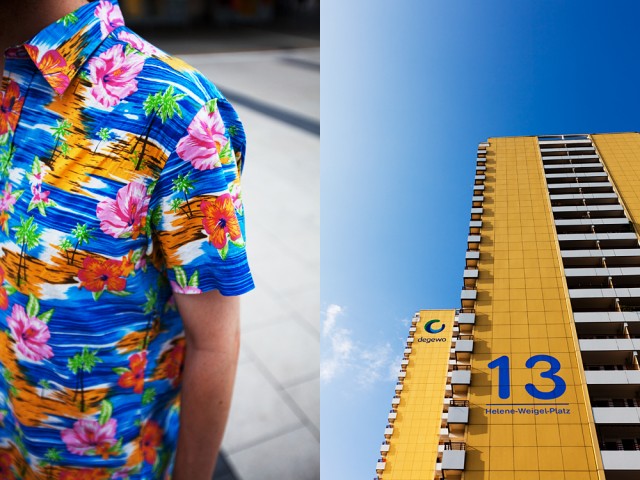
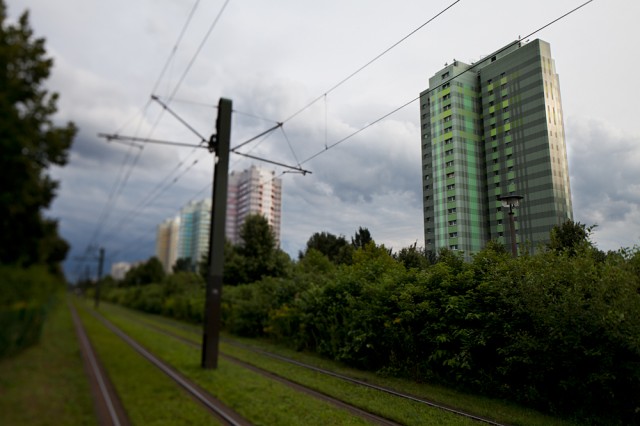

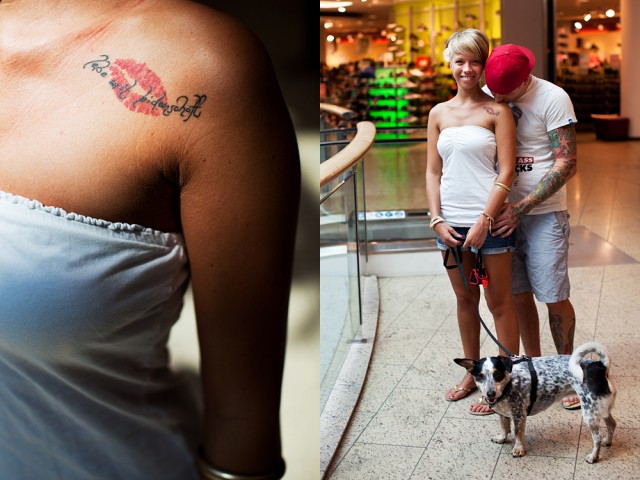



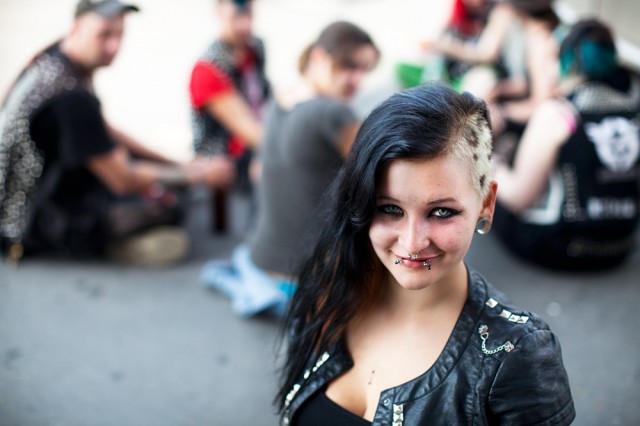
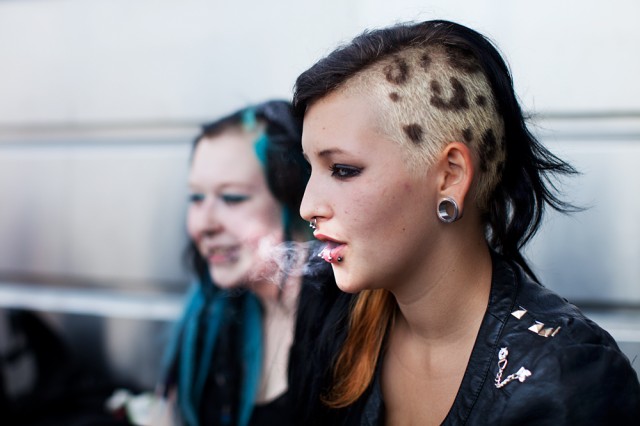



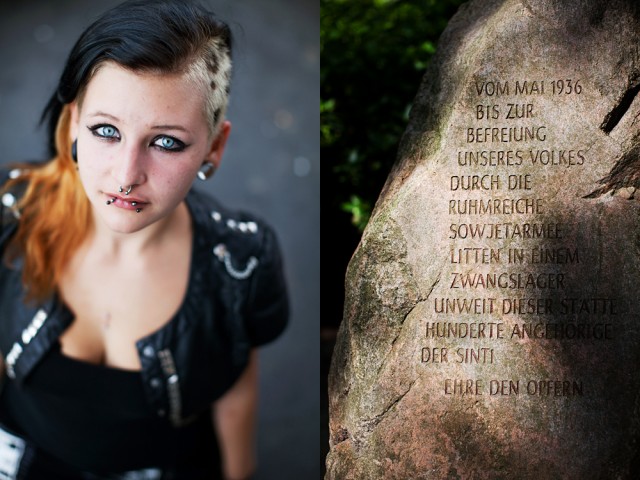
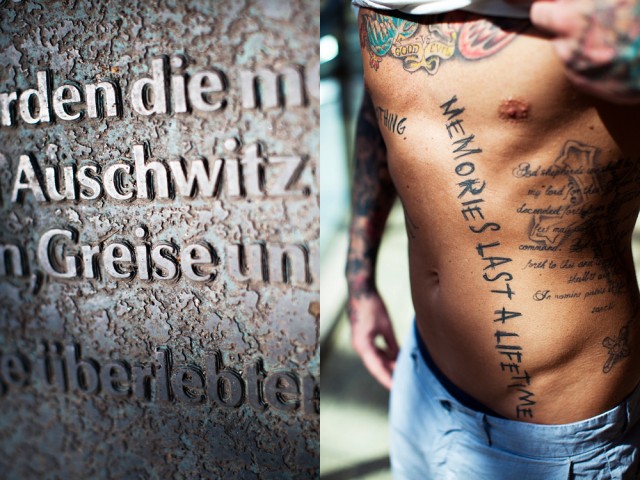
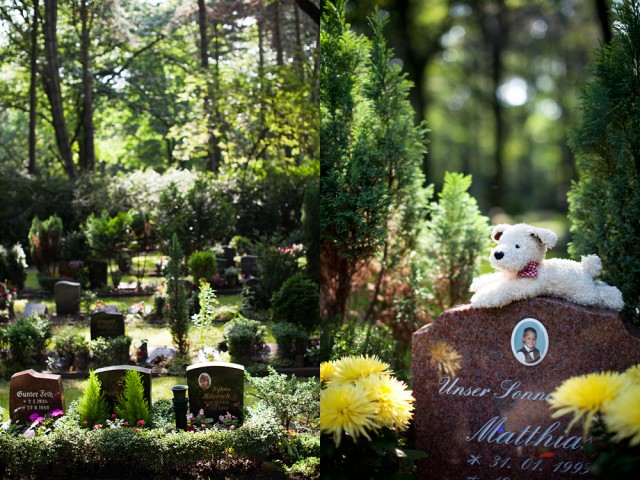

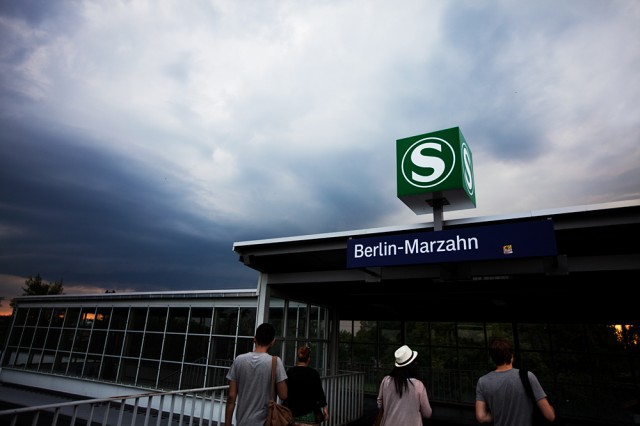
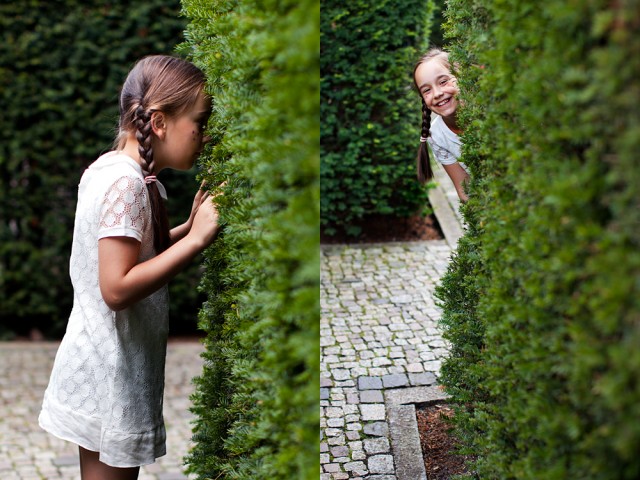




Lsia says:
(I am a reader and a New Yorker. Would be happy to answer questions should you have.)
Sarah says:
I love when I ‘remember’ to check here, and there’s a new suburb. I really liked this suburb – I felt less doom and gloom than previous weeks, which is weird, cause you were a little self conscious about that! I loved the map with the german map nails – was that you or Coco, or a stranger? I loved the orange retro dress. I love that nothing (seems) to scare you – I’d be less than confident to ask for those punks photos, but they are amazing! I find the Roma story tough (I just watched a law and order about Roma in NYC) It really is puzzling that ‘young’ people feel strongly about East/west – I suppose it’s like Sydney’s stereotypes of diff regions (Shire, North shore etc etc) – it’s a real shame there’s no social outlets for the youth, I really think that does make issues start… Idle minds and hands are no good! And a dog in a shopping centre (as they say, only in Germany!) And I loved Coco’s top/dress in the maze! (and her lush thick hair!)
Ann says:
I think this is one of the most interesting posts you’ve done so far.
Rob Steer says:
Another beautifully photographed and written piece. I felt totally transported and enthralled by the story and your project overall.
I await the next missive with bated breath…
marjan says:
this is such a joy to read and enjoy – both the text and the beautiful images – thank you. as an european born australian and passionate photographer your shared stories are something i look forward to reading every week. i agree with sarah – coco and you are indeed couragous and inspiring – thanks for sharing.
Belinda says:
Oh my goodness, that little monk in training is gorgeous! So cute and cheeky!
Louise says:
Lsia – Unlike Berlin, I’ve been to NY a few times – but it’s great to have locals to call on so thank you.
Sarah – Coco’s nails! And dogs seem to be allowed anywhere here – on trains, in shops, very cute. (BTW, if you don’t want to miss an installment, just subscribe – top right-hand button.)
Ann – It’s a pretty interesting area – the history is in your face, not buried away in museums etc. And on top of that, the monks, punks etc. A good week.
Rob – Danke! So good to know you love it.
Marjan – That’s wonderful, thank you. I don’t know about being courageous though – more just incredibly curious and driven to discover and learn. But I’ll happily take the inspiring label – I love that one.
Belinda – Dominique is a beautiful kid. Like I said, he managed to be a normal cheeky kid while at the same time so polite and serene too.
Lisa says:
Am loving all your posts and looking forward to New York. My family have been trying to get me to come and watch the Olympics but I just want to read your blog and look at your wonderful photos. That mosaic ‘exotic’ photo looks beautiful.
Brigitta says:
Dear Louise
Great blog as always
Just a minor correction
It should read ” honour to the victims” and not honour the sacrifice
Cheers
Brigitta
Sivan says:
Keep me posted when you come to New York. Would love to show you around from a photographer point of view
http://www.sivanaskayo.com
Tim says:
Loved it… best thing about going to “ugly” suburbs is that you find some beautiful things to photograph.
Louise says:
Lisa – Yeah, who needs the Olympics when you have this project!
Brigitta – Google Translation is good but not infallible I guess – many thanks for the correction.
Sivan – Great, thank you.
Tim – So glad you enjoyed it! It felt like I’d left Berlin in a way – so different to everything I’d seen.
Sarah says:
Hrmm thanks, I could subscribe, but I think I like the serendipitous ‘finding’ new content – weird but true!
Louise says:
Sarah – I know what you mean – serendipity is very cool.
Camille says:
Your pictures are gorgeous as usual, I really enjoy travelling with you through my own city. You made me discover new places, thanks a lot !
Louise says:
Camille – Bitte schön! Glad you’re on the tour bus.
Lynn says:
You are wonderful! Thank you for bringing the world closer. Love the photos, the insight, the humanity. You have validated the identity of the suburbs and the people that live and work there. Brilliant dedication and work. Look forward to coming with you on the journey – may it long continue.
Louise says:
Lynn – This project is intense and exhausting but comments like yours keep me going – many thanks!
Helga says:
I love your blog and the view in the places, never seen that before. We visit the Gärten der Welt once a year, but try to ignore Marzahn around it. It will be funny spend more time there by the next visit and try to find out something new there for ourselves :-) Thank you for sharing your special view on people and streets, it makes my day (have bought the Sydney-suburbs-book and love it, love the view on similarities in the difference, and on the details and and…and would like to meet you and Coco for a hoop-play again – glad to met you and have a good traveling next week and lots of fun, friendlyness and great pictures to fill your memories!)
Louise says:
Helga – Hello! You’ve made my day just by checking in here. We had so much fun in Hansaviertel with you and the girls that day – and I loved seeing my daughter racing around with other kids – an overdue playdate! You were very kind to let us into your life (and your apartment!) that afternoon. Hope you can keep following this project and if you ever make it down to Sydney, please let me know.
nick mclaren says:
Berlin had the Olympics too, remember. It’s really worth going to the old Olympic Stadium to check out all the statues of so-called Ayran gods on earth, if they haven’t been removed. I loved your Marzhan post. I remember it being a scary place – don’t ask me why we went there. But I do recall neo-Nazis on the train freaked us out to the point where we didn’t speak English all the way beck to Zoo Bahnhoff. And as for the Vietnamese cigarette smugglers, when we caught the train to Poland from Berlin the police or border guards removed a whole carriage wall that seemed to be stuffed full of cigarettes heading east. Maybe the smugglers have now moved further east too. Can’t wait to see your last Berlin post. Tschuss.
Louise says:
Nick – I knew about the 1936 Berlin Olympics and kept thinking about them when we were watching the London Olympics. Different eras of course but how different – aside from anything, London didn’t clear out the Roma gypsies or their version of ‘undesirables’ as Berlin did just before the games.
Red Peony says:
Louise – Another lovely post; gorgeous set of photos of the monks, especially those of the “saffron blur” & “clearing the mind” diptych. It’s amazing to see Coco growing by the week!!
Louise says:
Red Peony – Coco has been growing like weeds recently. Must be the masses of German sausages and bread she’s consuming. Glad you enjoyed the post.
Karen says:
Louise – thanks for the dedication to a Berlin suburb for me…one of my fav cities. Great photos and info as always. Have only just had a chance to check out the blog as I have been os myself far away from internet and the real world but thanks again.
Enjoy NYC!
Louise says:
Karen – My pleasure! Thanks for your support.
Peter McConnochie says:
Just catching up….been away the last few weeks!
Thanks for digging under the grey to find beauty…this post reminds me that life is beautiful :)
Louise says:
Peter – Life is beautiful indeed. Easy to forget sometimes when weighed down by the small stuff but really, what a thing, to be born at all!
Kerstin says:
I just discovered this now. But I love it, good work! Did you know, the garden gnomes originally are Turkish. And now they are considered typically German…
Louise says:
Didn’t know that, thank you for enlightening!
Kieron says:
Superb photography.
Louise says:
Danke!
Bob Altwein says:
What interesting insights about Marzahn. Stumbled upon your post and was in the same “Kiez” (or “hood”) back in 2010. Engaging commentary and photos. Thanks!
bob (in vancouver)
Euan Fleming says:
Great Article thanks a lot for posting was very interesting!
I am an architecture student from Scotland in the middle of writing my dissertation about housing in berlin, do you know any books i could call on to help me read further about this estate?
Thanks!
Louise says:
I’m glad you enjoyed the piece but I’m sorry, I don’t have any resources I could point you to. Best of luck with your work.